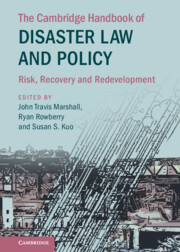Book contents
- The Cambridge Handbook of Disaster Law and Policy
- The Cambridge Handbook of Disaster Law and Policy
- Copyright page
- Dedication
- Contents
- Figures
- Maps
- Tables
- Contributors
- Foreword: Current Trends in Disaster Law and Policy
- Acknowledgments
- Introduction
- Part I Critical Perspectives on the Evolution of Disaster Law and Policy
- Part II Effective Governance as an Imperative for Responsive Disaster Law and Policy
- Part III Law’s Role in Promoting Hazard Mitigation: Intergovernmental, International, National, and Local Approaches
- 9 Local Resilience, Land Use Law, and Disaster Planning
- 10 Financing City Resilience
- 11 Disaster, Land Use, European Union Law and the Impact on EU Member States: The Relevance of the 2019 Decision of the Dutch Supreme Court Ordering Cuts in Greenhouse Gas Emissions
- 12 Covid-19 and Cooperation in Times of Disaster
- 13 Disaster Recovery in Rural Communities
- 14 Wildfire Federalism: A Framework for Local Government Participation in Disaster Planning
- 15 A Comparative Review of Hazard-Prone Housing Acquisition Laws, Policies, and Programs in the United States and Aotearoa New Zealand: Opportunities to Improve Practice
- 16 Urban Transformation as a Resilience Strategy: Earthquake Preparedness in Istanbul
- 17 How Do Green Cities Prevent Disasters?
- 18 Constructing a Resilient Energy Supply
- 19 Building a Resilient Power Grid
- 20 Weaponizing Private Property and the Chilling Effect of Regulatory Takings Jurisprudence in Combating Global Warming
- Part IV Private Sector Initiatives to Promote Disaster Resilience and Recovery
- Part V Lawyers As Disaster Law and Policy Leaders: Training for Students and Guidance for Practitioners
- Part VI Cultural Heritage Protection and Cross-Disciplinary Opportunities for Advancing Disaster Law and Policy
- Part VII Disasters and Vulnerable Communities
20 - Weaponizing Private Property and the Chilling Effect of Regulatory Takings Jurisprudence in Combating Global Warming
from Part III - Law’s Role in Promoting Hazard Mitigation: Intergovernmental, International, National, and Local Approaches
Published online by Cambridge University Press: 27 October 2022
- The Cambridge Handbook of Disaster Law and Policy
- The Cambridge Handbook of Disaster Law and Policy
- Copyright page
- Dedication
- Contents
- Figures
- Maps
- Tables
- Contributors
- Foreword: Current Trends in Disaster Law and Policy
- Acknowledgments
- Introduction
- Part I Critical Perspectives on the Evolution of Disaster Law and Policy
- Part II Effective Governance as an Imperative for Responsive Disaster Law and Policy
- Part III Law’s Role in Promoting Hazard Mitigation: Intergovernmental, International, National, and Local Approaches
- 9 Local Resilience, Land Use Law, and Disaster Planning
- 10 Financing City Resilience
- 11 Disaster, Land Use, European Union Law and the Impact on EU Member States: The Relevance of the 2019 Decision of the Dutch Supreme Court Ordering Cuts in Greenhouse Gas Emissions
- 12 Covid-19 and Cooperation in Times of Disaster
- 13 Disaster Recovery in Rural Communities
- 14 Wildfire Federalism: A Framework for Local Government Participation in Disaster Planning
- 15 A Comparative Review of Hazard-Prone Housing Acquisition Laws, Policies, and Programs in the United States and Aotearoa New Zealand: Opportunities to Improve Practice
- 16 Urban Transformation as a Resilience Strategy: Earthquake Preparedness in Istanbul
- 17 How Do Green Cities Prevent Disasters?
- 18 Constructing a Resilient Energy Supply
- 19 Building a Resilient Power Grid
- 20 Weaponizing Private Property and the Chilling Effect of Regulatory Takings Jurisprudence in Combating Global Warming
- Part IV Private Sector Initiatives to Promote Disaster Resilience and Recovery
- Part V Lawyers As Disaster Law and Policy Leaders: Training for Students and Guidance for Practitioners
- Part VI Cultural Heritage Protection and Cross-Disciplinary Opportunities for Advancing Disaster Law and Policy
- Part VII Disasters and Vulnerable Communities
Summary
Forty years ago, the Supreme Court created a new doctrine to protect property rights, called regulatory takings. That doctrine is an answer in search of a problem. The well-established law of eminent domain had developed over a century ago relatively clear guidance on how to distinguish between government actions that took someone’s property, thus requiring compensation, and government actions that merely regulated property and did not require compensation. Ignoring the long tradition in eminent domain, the Court has created an entirely new, completely incoherent, and fundamentally flawed constitutional jurisprudence that hampers the ability of governments to address the critical threats of climate change. But even within the Court’s incoherent regulatory takings doctrine, there are lessons for state and local governments on how to better prepare for disaster resilience and address the inequitable effects of climate change. This chapter explores the constitutional limitations on governments in their efforts to regulate to protect against climate disasters and identifies possible strategies for responding to climate events within the parameters of the Court’s incomprehensible property jurisprudence.
Keywords
Information
- Type
- Chapter
- Information
- The Cambridge Handbook of Disaster Law and PolicyRisk, Recovery, and Redevelopment, pp. 327 - 350Publisher: Cambridge University PressPrint publication year: 2022
